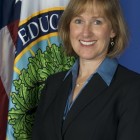
flickr:katerha
In the third installment of my interview with Karen Cator, Director of Educational Technology at the Department of Education, we talk about how transparency in the digital age can help to motivate the education community to push for progress.
I've heard a lot of frustration from the education community about decision-makers either not showing interest or being unable to push for some of the progressive tactics detailed in the National Education Technology Plan. What can educators, parents, or others do to help keep the momentum going from the ground level, even when it's stalled at the top?
I think we need to increase transparency around what’s happening in schools today. A school might be perfectly happy with the system they have if they’re meeting the needs of students. If that’s the case, they don’t have much inclination to try something new.
If, however, they have students who are not engaged, not coming to school, or those who are graduation but still needing remedial assistance wherever they go, or graduating but not being prepared for what they need to do next -- if we build transparency around the kind of data and outcomes that are happening now, people will have more of an inclination to try some new models.
That said, I think we need transparency around schools that have been successful. What we have now is that everyone’s trying to figure out how to do it all over again. So we’re doing some work around how we can we build much more collaboration and interaction online for education professionals so people can find places that are like them or a little ahead of them, so they can follow rather than figuring it out on their own all over again.


